![[The pies have it]](../jpg/wigwam.jpg)
[ Home | Staff & Contacts | HiFi Playground | Listening tests | DIY & Tweakings | Music & Books ]
![[The pies have it]](../jpg/wigwam.jpg)
The show: HiFi Wigwam;
Venue: The Scalford Hotel, LE14 4UB;
Show review by: Mark Wheeler - TNT UK
Visited March 2015
As the weekend of Wigwam 2016 approaches, here are some notes from Wigwam 2015 to persuade any waverers to get on their bikes and go.
![[HiFi Wigwam]](../jpg/wigwam_logo.jpg)
HiFi Wigwam is a well known audiophile discussion board that has the usual opinionated outbursts and arguments, but fewer flames than most.
This seems odd given that we expect wigwams to be arranged in circles around a campfire.
One of the qualities that separates Wigwam from most other discussion boards is that members put their money where their mouths are (useful in the pork pie capital of the UK) and meet annually to demonstrate their systems to each other.
So the HiFi Wigwam show is as different from other shows as their discussion board is different from other discussion boards. There are no commercial exhibitors unless they also happen to be Wammers (the collective noun for Wigwam participants)
and no pressure from anyone to buy anything more significant than a raffle ticket.
The show has been running for 6 years and revels in a central location close to the M1 half-way up (or down, depending where you start the journey) that motoring spine of England replacing the Great North Road, which in turn superseded Roman Ermine Street as the spinal cord of England (Roman Britain stopped at the Antonine Wall and North of Hadrian's Wall folk were mostly grooving with a Pict).
The Wigwam itself, of course, is advertising funded, which is where it differs from the anarcho-syndicalists of TNT-audio.com. Indeed they were shocked to hear that we're not paid journos over here at TNT-audio; this is simultaneously a compliment to our professionalism and an affront to our image as starving artists in a garret.
The show congregates at the Scalford Hall Hotel, which is not far from Melton Mowbray, the Leicestershire town, which dubs itself the UK rural capital of food. Melton Mowbray is famous for its Walker's Crisps (endorsed by former footballer Gary Linneker), Pork Pies (a meat pie characterised by spices and savoury jelly), Stilton Cheese (not actually made in the village of Stilton) and 4 million items of petfood every day.
Melton Mowbray became prosperous due to its close proximity to the Roman main road, the Fosse Way, as it does now with its proximity to the M1 motorway. The central location and access to food and drink are clearly great
motivators to Wammers, along with a low admission charge of £14, as testified by the excellent attendance.
Melton Mowbray was the originator of the expression 'Painting the town red', when a drunken hunting party daubed copious quantities of red paint onto the walls and doors of High Street buildings.
For those unfamiliar with English geography, Leicestershire is a county situated roughly midway between the industrial powerhouses of Northern England and the home counties heartlands of London Commuter hinterland.
This is the location's biggest asset because it is easy to get to from much of England
and Wales (Scottish visitors have more of a trek) and lies between Britains main artery and main vein, the M1 motorway and the A1 Great North Road.
Rail access would be pitiful, but who is going to drag their Goldmund Reference onto a train carriage?
On arrival, your old scribe wondered what else was happening, at the venue. The cars parked up to 1km in either direction along the road implied a society wedding at the very least. The men at the entrance to the drive suggested parking on the
verges of the rural road, like dozens of other cars before. After lugging camera gear to the drive it transpired the drive was also parked solid. Reaching the venue, the car parks were all full too. This is an amazing attendance, given the exaggerated
tales of the death of the home audio hobby and also suggests the central location is key to attracting visitors from all over the forum.
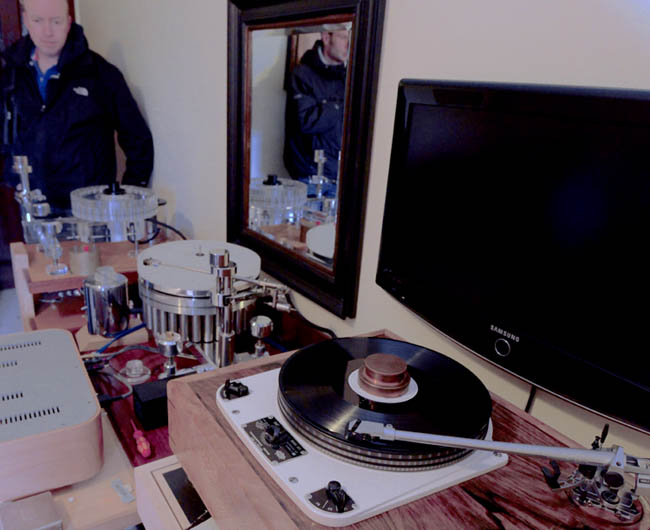
Your old scribe hasn't participated in audio discussion boards or even read them with any regularity, since becoming a reviewer and author for TNT-audio.com. However, www.hifiwigwam.com is an exception worth checking out. The flames and hostility that sometimes plague other blogs tend to be damped down quickly by other 'Wammers' and the in-jokes are thankfully few and far between. HiFi Wigwam manages to achieve a sense of community by inviting inclusivity, rather than promoting exclusion by desperately adhering to dogma. The inevitable consequence of the 'exclu' root of exclusivity is that it breeds exclusion. Another, equally welcoming, forum described Wammers them as “trough types, given to fighting and harsh words”. Your old scribe met nowt but friendly folk, given to waxing lyrical about each other's systems and there is clearly a friendly rivalry between these two well-known British based discussion boards.
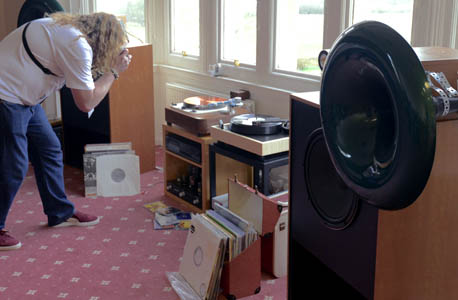
The Lenco Room hosted an affable bunch determined to prove that you can break the rules and still enjoy the tunes without noise. 3 decks were in plinths on a sagging sideboard that bowed down to the centre under the weight of all this idling metal. That none were even level didn't seem to bother anyone and the fourth had no plinth but hung in a rough cut piece of sagging 12mm MDF. Your old scribe shared his views on MDF and a lively discussion ensued.
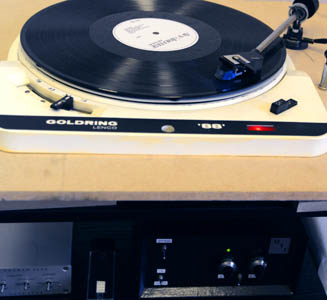
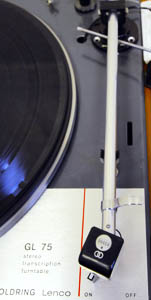 "Lively discussion?" challenge plebs chorus, stage left, "The old scribe would make anyone using MDF walk the MDF plank if he had his way"
"Lively discussion?" challenge plebs chorus, stage left, "The old scribe would make anyone using MDF walk the MDF plank if he had his way"
"Birch ply (or even chipboard) would still prove the same economy point and would sound even better!" Retorts the Old Scribe.
Colin had a Lenco GL70 (often rebranded as Goldring in the UK) with a classic Audio-Technica arm (those vintage Japanese arms are still often bargains compared with vintage SME etc). There was a Lenco GL75 in its original plinth with the first gimbal Decca FFSS arm your Old Scribe has ever seen in the flesh, as opposed to the more common damped unipivot Decca International arm. It was carrying an original Decca FFSS (Full Frequency Stereo Sound) headshell cartridge, and the remains of an old Watts Dust Bug provided the pillar base. This is the original version of the Decca sum and difference cartridge. Later 1/2" centre Decca cartridges were mounted on flimsy plastic brackets to allow quick changes between LP and 78 cartridge bodies. The integrated Decca FFSS cartridge-headshell has more... well, integrity.
Mike was running a Lenco GL88 with a Connoisseur SUA2 pick-up arm carrying that bargain modest step up from the ubiquitous starter Audio Technica AT95E, an Audio Technica AT110E. The Connoisseur arm was unique in that it used diagonally orientated bearings rather than the more common horizontal and vertical bearings. This put the bearings on the axes of the groove walls and allowed bias compensation to be effected by a weighted rod that simply rode up with the bearing housing as the arm traversed the record. This removes a whole set of possibly resonant or friction inducing components compared with more common arrangements. All the Wammers in the Lenco room were using their own voltage step-down arrangements or motor control circuits. This reduces motor noise on idler turntables like the classic Lencos and the Garrard 301/401 and in one case provided fine speed control instead of relying on the Lenco tapered pulley. They were all using a Gainclone amplifier and Jordan J92 drivers in Jimmy Chang plywood boxes with biscuit joints. That is as good as it gets in cabinet construction and the sounds in the room were excellent.
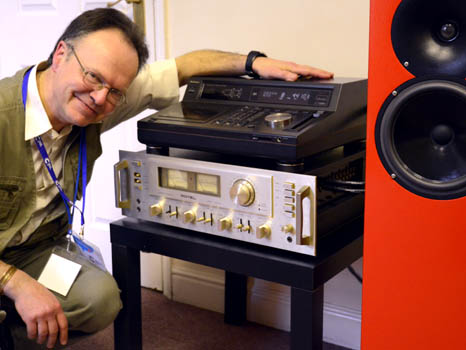
 Jerry and matt shared a room to demonstrate their respective loves of vintage 70s gear and home designed and built loudspeakers. Jerry's sources included a 1st generation technics SLP1200CD player.
Like most home constructors, Matt couldn't find exactly the combination of features he wanted in one loudspeaker so he designed and built his own. The quality sounds emerging from his Vifa 8 bass
drivers crossed over to Monacor Tweeters with Monacor waveguides belied the fact that he has been designing and building for only 3 years. The massive coils in his
passive crossovers demonstrate how difficult it is to get reasonable sound without going active. There was none of the dynamic compression usually heard from smaller coils,
but he could have bought a second stereo amplifier and an electronic crossover for less brass and we had an agreeable conversation about all things speakerish.
Jerry and matt shared a room to demonstrate their respective loves of vintage 70s gear and home designed and built loudspeakers. Jerry's sources included a 1st generation technics SLP1200CD player.
Like most home constructors, Matt couldn't find exactly the combination of features he wanted in one loudspeaker so he designed and built his own. The quality sounds emerging from his Vifa 8 bass
drivers crossed over to Monacor Tweeters with Monacor waveguides belied the fact that he has been designing and building for only 3 years. The massive coils in his
passive crossovers demonstrate how difficult it is to get reasonable sound without going active. There was none of the dynamic compression usually heard from smaller coils,
but he could have bought a second stereo amplifier and an electronic crossover for less brass and we had an agreeable conversation about all things speakerish.
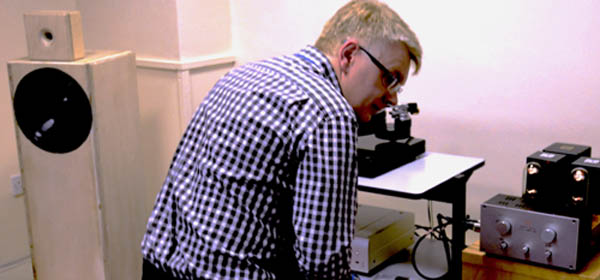
Equally fine loudspeakers were Des's Robert Bastani drivers in birch ply (hear what I mean?) cabinets. There was no cabinet colouration whatsoever from these 25mm and 30mm birch plywood boxes. They provided the driver with loading by exponential profile back horns and use simple 1st order (6dB/octave) crossovers. They only way they could be bettered would be bi-amping with passive single component crossovers between pre-amplifier and power amplifier, or replacing the coupling capacitor between input stage and driver stage with a value to provide high-pass for the treble section amplifiers.
"He's off again," quoth plebs chorus, stage left, "Droning on against passive crossovers again"
I'm honour bound then to say that Dan's ATC clones were sounding good! They were driven by Hypex modules, demonstrating that it isn't the circuit that matters, it's the way that it's used.
Your Old Scribe has never heard Hypex modules sounding half decent before and wondered why so many people liked them. They were helped by good power supplies and wonderful casework. The latter was machined from billet stock by Adam, who will do the same for you if you cross his palm with enough silver. On the other hand the experimental set-up with an array of four Quad ESL57, mounted horizontally and driven by NCore amps was not giving its best during a visit to the low ceilinged attic. Clever use of carpet tubes as diffusers (also often in your Old Scribe's room taming armory) didn't succeed in ameliorating some of the confined space induced problems affecting these dipole radiators (in every sense of the word).
You had to love their scrupulous attention to mains cabling, which must have cost them thousands (of Green Shield Stamps). Rick's Impulse H2's were sounding great and for a moment looked like they had the rare double magnet version of the fibreglass inverted dome Focal TC120 but Rick assured me they were the standard fibreglass single magnet TC120. Impulse did seem to change their specification with every batch, back in the day, and every variation has its own strengths, but transparency was always one of them.
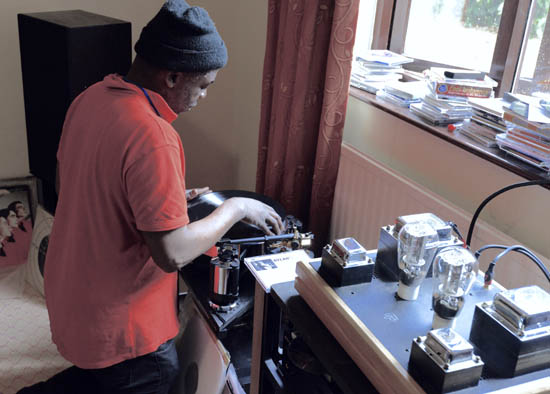
Other rooms included Paul's Garrard 301 and a silver SME312 carrying a carbon fibre Audio Tekne with a mono Ortofon SPUGTE on its parent arm.
This was one of those rich and powerful rooms that manage to be both old-skool and dynamic and sweet at the same time. Bob had another Garrard 301, this time running an aluminium tubed SME312, which many people argue
sounds more natural and flowing than the magnesium arms.
He also had examples of the
SPJ turntables
that were the magnificent forerunners of the equally magnificent Teres beasts with 30kg platters on 19mm bearing shafts. The SPJ turntables are worth mentioning not only because they are engineering tours de force,
but because they are design icons and because they were designed by a woman. Women used to be thin on the ground at audio shows, apart from those poor souls dragged along by their audio obsessed partners, but at Wigwam
female participation was a both a little higher in number and slightly less reluctant. Bob was using single-ended triode power amplifiers featuring 211 output valves that were creating surprisingly tight bass from Mission loudspeakers.
A Garrard 401 in an Appollo Slab Tech plinth graced Steven;s room. This is not the Appollo of audio rack fame, but a brand of kitchen work surface material widely available from British builder's merchants. He told me fellow Wammer, Nick longford, impulse tests materials and identified this dense composite as superior to the usual compressed sawdust and glue alternatives. Apollo Slab Tech is manufactured from mineral filled polyacrylate/polyester resins (just like the cabinets of some 6 figure loudspeakers) and sounded as unlike MDF as it would be possible to achieve from a plank.
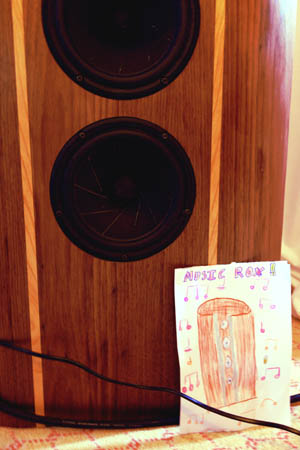
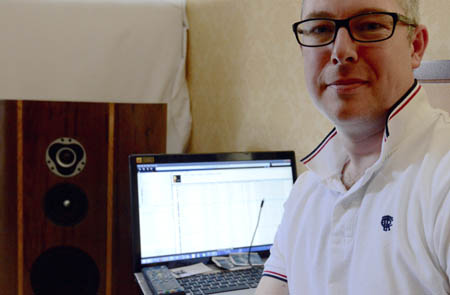 Speaking of materials, Staphan was demonstrating a pair of the most beautiful active 3.5way loudspeakers. They were so beautiful his little daughter had designed a brochure for them that she slipped into the box for him to
discover when he unpacked them for the show. He was using software controlled crossovers, within his server PC and making some of the best sounds achieved in the tiny rooms. Paul was suing the only fully functional Lux
vacuum platter turntable your Old Scribe has heard in 20 years. It sounded as good as remembered, too.
Speaking of materials, Staphan was demonstrating a pair of the most beautiful active 3.5way loudspeakers. They were so beautiful his little daughter had designed a brochure for them that she slipped into the box for him to
discover when he unpacked them for the show. He was using software controlled crossovers, within his server PC and making some of the best sounds achieved in the tiny rooms. Paul was suing the only fully functional Lux
vacuum platter turntable your Old Scribe has heard in 20 years. It sounded as good as remembered, too.
Despite not being Paul Messenger (of HiFi News, HiFi Choice and HiFi Critic fame), Paul was using Rehdeko loudspeakers; these quaint looking, engineering eccentrics,
being not quite 2-way, not quite full-range eliptical driver sealed boxes, which also sounded as dynamic and single-minded as your Old Scribe's overloaded audio memory recalls.
Another room with Seagull Omnis was not showing them to their best advantage, with a quaint old Yamaha receiver and table and mismatched stands causing additional early reflections to those already present in the badly arranged room, despite being crowded. The equally quaint hand drawn diagrams had qualities of Outsider Art and provided neither useful information nor arguments in favour of the ideas. It seemed like a wasted opportunity for someone who had put so much time and effort into the project that I hope they're back next year to show them to better advantage.
Local boys Chevron Audio and also had an active loudspeaker demonstration using external active crossovers and modular amplifiers to help anyone go active. They also had the simplest Linn modification, the Spoke, designed to ameliorate the commonnest problem of subchassis-on-springs turntables, that years of obsessive set-up aims to solve. The second Audio Note (Japan) Ongaku of the day was joined by well made Lowther full range horns supplemented by stonking transmission-line subwoofers driven by superb old Kef B139 drive units. These malcolm Jones designed 60s classic solid polystyrene coned drivers have been favourites of transmission-line and tuned quarter-wave pipe (TQWP) designers since Bailey & Radford first proposed their use in their 1965 Wireless World and commercial designs and Bailey again in his 1972 triangular line design.
 Another forum
described Wammers as "rough types, given to fighting and harsh words". Your old scribe met nowt but friendly folk, given to waxing lyrical about each other's systems.
The forum in-jokes are thankfully few and far between. HiFi Wigwam manages to achieve a sense of community by inviting inclusivity, rather than promoting exclusion
(the inevitable consequence of the 'exclu' root of exclusivity) by desperate adherence to one dogma or another.
Another forum
described Wammers as "rough types, given to fighting and harsh words". Your old scribe met nowt but friendly folk, given to waxing lyrical about each other's systems.
The forum in-jokes are thankfully few and far between. HiFi Wigwam manages to achieve a sense of community by inviting inclusivity, rather than promoting exclusion
(the inevitable consequence of the 'exclu' root of exclusivity) by desperate adherence to one dogma or another.
The day ended for your Old Scribe in the room where the material contrasted more with the equipment than any other. Another full Audio Note (Japan) system was unexpectedly rocking out to end your Old Scribe's day in the country, with Steve ironically sporting a Linn shirt while doing the deejay thing on a classic Technics. This just about sums up the irreverent, and indeed often ironic, attitude of the Wammers having fun.
The Wigwam Show is much more fun than a trade show. It's in the middle of England, if not the British Isles, so what's not to like. If you're free on Sunday 20th March 2016 you should go. There were too many iconoclastic or just plain far-out audio experiments to cover here, so you really have to go yourself. There was the Quad Laboratory in the attic, with their fine attention to cable controversies. There were Impulse and Rehdeko loudspeakers rarely seen for a decade and even when new were designs harking back to earlier times. Bagpuss appears as a vibration control device and equally rarely seen old material from the BBC were some splendid LS5/8 monitors and magnificent tape recorders. Here are some more pictures to entertain you.
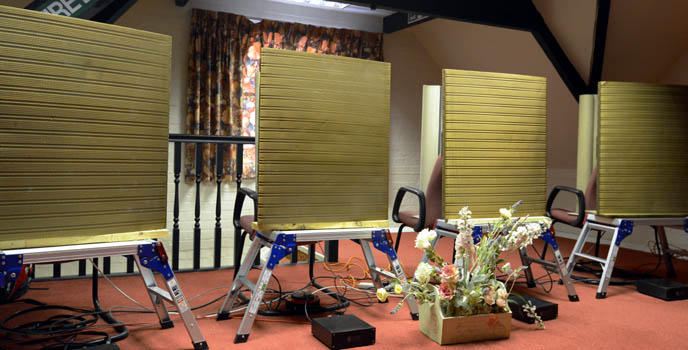
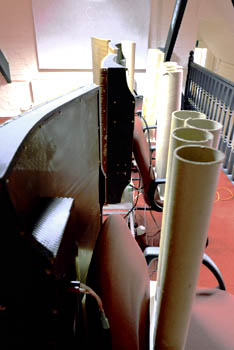
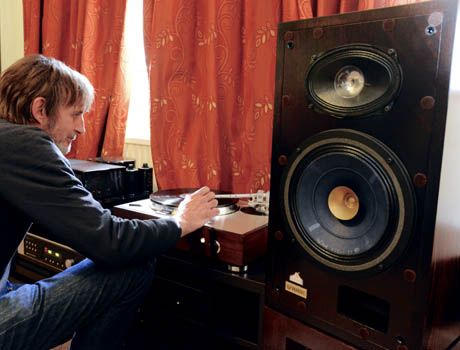
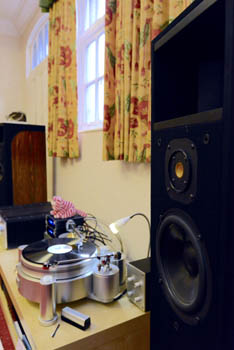
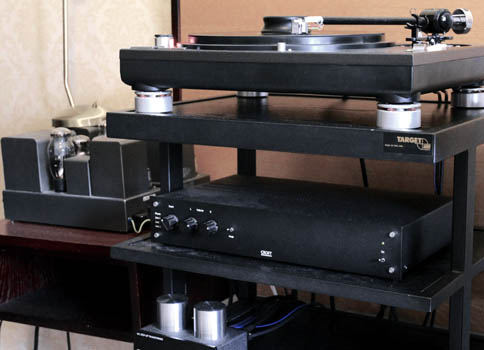
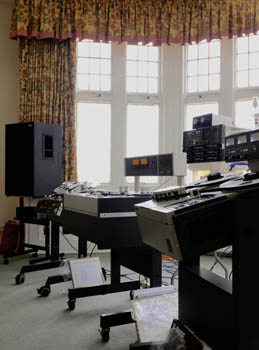
© Copyright 2016 The Old Scribe - mark@tnt-audio.com - www.tnt-audio.com
[ Home | Staff & Contacts | HiFi Playground | Listening tests | DIY & Tweakings | Music & Books ]